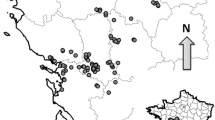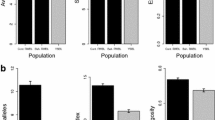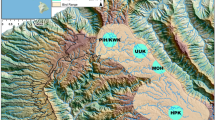Abstract
Many island avian populations are of conservation interest because they have a higher risk of extinction than mainland populations. Susceptibility of island birds to extinction is primarily related to human induced change through habitat loss, persecution, and introduction of exotic species, in combination with genetic factors. We used microsatellite profiles from 11 loci to assess genetic diversity and relatedness in the critically endangered hawk Buteo ridgwayi endemic to the island of Hispaniola in the Caribbean. Using samples collected between 2005 and 2009, our results revealed a relatively high level of heterozygosity, evidence of a recent genetic bottleneck, and the occurrence of inbreeding within the population. Pair relatedness analysis found 4 of 7 sampled breeding pairs to be related similar to that of first cousin or greater. Pedigree estimates indicated that up to 18 % of potential pairings would be between individuals with relatedness values similar to that of half-sibling. We discuss our findings in the context of conservation genetic management suggesting both carefully managed translocations and the initiation of a captive population as a safeguard of the remaining genetic diversity.





Similar content being viewed by others
References
Addison JA, Diamond AW (2011) Population genetics and effective population size of the critically endangered Nihoa Millerbird (Acrocephalus familiaris kingi). Auk 128(2):265–272
Bellinger MR, Johnson J, Toepfer J, Dunn P (2003) Loss of genetic variation in greater prairie chickens following a population bottleneck in wisconsin, USA. Conserv Biol 17(3):717–724
Bijlsma R, Bundgaard J, Boerema AC (2000) Does inbreeding affect the extinction risk of small populations? predictions from Drosophila. J Evol Biol 13:502–514
Billing AM, Lee AL, Skjelseth S, Borg AA, Hale MC, Slate J, Parn H, Ringsby TH, Sæther BE, Jensen H (2012) Evidence of inbreeding depression but not inbreeding avoidance in a natural house sparrow population. Mol Ecol 21:1487–1499
Blomqvist D, Pauliny A, Larsson M, Flodin LA (2010) Trapped in the extinction vortex? strong genetic effects in a declining vertebrate population. BMC Evol Biol 10:33
Bollmer JL, Whiteman NK, Cannon MD, Bednarz JC, de Vries T, Parker PG (2005) Population genetics of the Galápagos hawk (Buteo galapagoensis): genetic monomorphism within isolated populations. Auk 122:1210–1224
Bollmer JL, Hull JM, Ernest HB, Sarasola JH, Parker PG (2011) Reduced MHC and neutral variation in the Galapagos hawk, an island endemic. BMC Evol Biol 11:143
Bolund E, Martin K, Kempenaers B, Forstmeier W (2010) Inbreeding depression of sexually selected traits and attractiveness in the zebra finch. Anim Behav 79:947–955
Boyer AG (2010) Consistent ecological selectivity through time in Pacific Island avian extinctions. Conserv Biol 24(2):511–519
Brown JW, Van Coeverden de Groot PJ, Birt T, Seutin G, Boag P, Friesen V (2007) Appraisal of the consequences of the DDT-induced bottleneck on the level and geographic distribution of neutral genetic variation in Canadian peregrine falcons, Falco peregrinus. Mol Ecol 16:327–343
Cornuet JM, Luikart G (1996) Description and power analysis of two tests for detecting recent population bottlenecks from allele frequency data. Genetics 144:2001–2014
Cory CB (1885) The birds of Haiti and San Domingo. Estes and Lauriat, Boston
Cristescu R, Sherwin WB, Handasyde K, Cahill V, Cooper DW (2010) Detecting bottlenecks using BOTTLENECK 1.2.02 in wild populations: the importance of the microsatellite structure. Conserv Genet 11:1043–1049
Di Rienzo A, Peterson AC, Garza JC, Valdes AM, Slatkin M, Freimer NB (1994) Mutational processes of simple-sequence repeat loci in human populations. Proc Natl Acad Sci USA 91:3166–3170
Dunn SJ, Clancey E, Waits LP, Byers JA (2011) Inbreeding depression in pronghorn (Antilocapra americana) fawns. Mol Ecol 20:4889–4898
Epperson BK, Allard RW (1987) Linkage disequilibrium between allozymes in natural populations of lodgepole pine. Genetics 115:341–352
Evans SR, Sheddon BC (2008) Interspecific patterns of genetic diversity in birds: correlations with extinction risk. Conserv Biol 22(4):1016–1025
Ewing SR, Nager RG, Nicoll MA, Aumjaud A, Jones CG, Keller LF (2010) Inbreeding and loss of genetic variation in a reintroduced population of Mauritius Kestrel. Conserv Biol 22(2):395–404
Excoffier LG, Laval G, Schneider S (2005) Arlequin ver. 3.0: an integrated software package for population genetics data analysis. Evol Bioinformatics Online. 1:47–50
Falush D, Stephens M, Pritchard JK (2003) Inference of population structure: extensions to linked loci and correlated allele frequencies. Genetics 164:1567–1587
Frankham R (1995a) Conservation genetics. Annu Rev Genet 29:305–327
Frankham R (1995b) Inbreeding and extinction: a threshold effect. Conserv Biol 9(4):305–327
Frankham R (1997) Do island populations have less genetic variation than mainland populations? Heredity 78:311–327
Frankham R (1998) Inbreeding and extinction: island populations. Conserv Biol 12:665–675
Frankham R (2005) Genetics and extinction. Biol Conserv 12:131–140
Frankham R (2010) Where are we in conservation genetics and where do we need to go? Conserv Genet 11:661–663
Gaut BS, Long AD (2003) The low down on linkage disequilibrium. Plant Cell 15:1502
Gautschi B, Gwenaël J, Negro JJ, Godoy JA, Müller JP, Schmid B (2003) Analysis of relatedness and determination of the source of founders in the captive bearded vulture Gypaetus barbatus population. Conserv Genet 4:479–490
Gilbert KJ, Andrew RL, Bock DG, Franklin MT, Kane NC, Moore JB, Moyers BT, Renaut SB, Rennison DJ, Veen T, Vines TH (2012) Recommendations for utilizing and reporting population genetic analyses: the reproducibility of genetic clustering using the program STRUCTURE. Mol Ecol 21:4925–4930
Goudet J (2001) FSTAT: a program to estimate and test gene diversities and fixation indices (version 2.9.3). http://www.unil.ch/izea/softwares/fstat.html. Accessed 12 July 2010
Groombridge JJ, Jones CG, Bruford MW, Nichols RA (2000) ‘Ghost’ alleles of the Mauritius kestrel. Nature 403:616
Groombridge JJ, Bruford MW, Jones CG, Nichols RA (2001) Estimating the severity of the population bottleneck in the Mauritius kestrel Falco punctatus from ringing records using MCMC estimation. J Anim Ecol 70:401–409
Groombridge JJ, Dawson DA, Burke T, Prys-Jones R, de L Brooke M, Shah N (2009) Evaluating the demographic history of the Seychelles kestrel (Falco area): genetic evidence for recovery from a population bottleneck following minimal conservation management. Biol Conserv 142:2250–2257
Guo SW, Thompson EA (1992) Performing the exact test of Hardy–Weinberg proportion for multiple alleles. Biometrics 48:361–372
Harcourt C, Ottenwalder JA (1996) Hispaniola. In: Harcourt CS, Sayer JA (eds) The conservation atlas of tropical forests, the Americas. IUCN, Gland, pp 102–111
Hedrick PW, Kalinowski ST (2000) Inbreeding depression in conservation biology. Annual Rev Ecol Syst 31:139–162
Hemmings NL, Slate J, Birkhead TR (2012) Inbreeding causes early death in a passerine bird. Nat Commun 3:863
Hille SM, Nesje M, Segelbacher G (2003) Genetic structure of kestrel populations and colonization of the Cape Verde archipelago. Mol Ecol 12:2145–2151
Huang Z, Liu N, Zhou T (2005) A comparative study of genetic diversity of peripheral and central populations of Chukar partridge from northwestern China. Biochem Genet 43:613–621
Hull JM, Tufts D, Topinka JR, May BP, Ernest HB (2007) Development of 19 microsatellite loci for Swainson’s Hawks (Buteo swainsoni) and other Buteos. Mol Ecol Notes 7:346–349
Hull JM, Anderson JR, Bradbury M, Estep JA, Ernest HB (2008) Population structure and genetic diversity in Swainson’s Hawks (Buteo swainsoni): implications for conservation. Conserv Genet 9:305–316
IUCN [online] (2010) IUCN Red List of Threatened Species. Version 2010.2. www.iucnredlist.org. Accessed 12 Nov 2012
James PC, Oliphant LW, Warkentin IG (1987) Close inbreeding in the Merlin (Falco columbarius). Wilson Bull 99:718–719
Johnson TH, Stattersfield AJ (1990) A global review of island endemic birds. Ibis 132:167–180
Johnson JA, Bellinger MR, Toepfer JE, Dunn P (2004) Temporal changes in allele frequencies and low effective population size in greater prairie-chickens. Mol Ecol 13:2617–2630
Johnson PCD, Fowlie MK, Amos W (2005) Isolation of microsatellite loci from the common buzzard, Buteo buteo (Aves : accipitridae). Mol Ecol Notes 5:208–211
Keller LF, Waller DM (2002) Inbreeding effects in wild populations. Trends Ecol Evol 17:230–241
Konovalov D (2006) Accuracy of four heuristics for the full sibship reconstruction problem in the presence of genotype errors.In: Jiang T, Yang U, Chen P and Wong L (eds) Proceedings of 4th Asia-Pacific bioinformatics conference. Imperial College Press, London, pp 7–16
Konovalov DA, Manning C, Henshaw MT (2004) KINGROUP: a program for pedigree relationship reconstruction and kingroup assignments using genetic markers. Mol Ecol Notes 4:779–782
Latta SC, Rimmer C, Keith A, Wiley J, Raffaele H, Mcfarland K, Fernandez E (2006) Birds of the Dominican Republic and Haiti. Princeton University Press, Princeton
Lebigre C, Alatalo RV, Siitari H (2010) Female-biased dispersal alone can reduce the occurrence of inbreeding in black grouse (Tetrao tetrix). Mol Ecol 19:1929–1939
Ludwig SC, Becker PH (2012) Immigration prevents inbreeding in a growing colony of a long-lived and philopatric seabird. Ibis 154:74–84
Martinez-Cruz B, David VA, Godoy JA, Negro JJ, O’Brien SJ, Johnson WE (2002) Eighteen polymorphic microsatellite markers for the highly endangered Spanish imperial eagle (Aquila adalberti) and related species. Mol Ecol Notes 2:323–326
Martinez-Cruz B, Godoy JA, Negro JJ (2004) Population genetics after fragmentation: the case of the endangered Spanish imperial eagle (Aquila adalberti). Mol Ecol 13:2243–2255
Myers N (1979) Islands of conservation. New Scientist 83:600–602
Nei M, Maruyama T, Chakraborty R (1975) Bottleneck effect and genetic variability in populations. Evolution 29(1):1–10
Nesje M, Roed KH, Lifjeld JT, Lindberg P, Steen OF (2000) Genetic relationships in the peregrine falcon (Falco peregrinus) analysed by microsatellite DNA markers. Mol Ecol 9:53–60
Newton I (1979) Population ecology of raptors. Buteo Books, Vermillion
Pimm SL, Raven P, Peterson A, Sekercioglu CH, Erlich PR (2006) Human impacts on the rates of recent, present, and future bird extinctions. Proc Natl Acad Sci USA 103:10941–10946
Piry S, Luikart G, Cornuet JM (1999) BOTTLENECK: a program for detecting recent effective population size reductions from allele data frequencies. J Heredity 90:502–503
Postupalsky S (1989) Inbreeding in Ospreys. Wilson Bull 101:124–126
Pritchard JK, Stephens M, Donnelly P (2000) Inference of population structure using multilocus genotype data. Genetics 155:945–959
Queller DC, Goodnight KF (1989) Estimating relatedness using genetic markers. Evolution 43:258–275
Reed DH, Briscoe DA, Frankham R (2002) Inbreeding and extinction: the effect of environmental stress and lineage. Conserv Genet 3:301–307
Reed DH, Lowe EH, Briscoe DA, Frankham R (2003) Inbreeding and extinction: effects of rate of inbreeding. Conserv Genet 4:405–410
Rimmer CC, Townsend JM, Townsend AK, Fernandez EM, Almonte J (2005) Avian diversity, abundance, and conservation status in the Macaya Biosphere Reserve of Haiti. Ornitol Neotropica 16:219–230
Rosenfield RN, Bielefeldt J (1992) Natal dispersal and inbreeding in the Cooper’s Hawk. Wilson Bull 104:182–184
Rousset F (2008) Genepop’007: a complete reimplementation of the GENEPOP software for Windows and Linux. Mol Ecol Resources. 8:103–106
Russello MA, Amato G (2004) Ex-situ population management in the absence of pedigree information. Mol Ecol 13:2829–2840
Seutin G, White BN, Boag PT (1991) Preservation of avian blood and tissue samples for DNA analyses. Can J Zool 69:82–90
Slatkin M, Excoffier L (1996) Testing for linkage disequilibrium in genotypic data using the expectation-maximization algorithm. Heredity 76:377–383
Smith FDM, May RM, Pellew R, Johnson TH, Walter KR (1993) How much do we know about the current extinction rate? Trends Ecol Evol 8:375–378
Spielman D, Brook BW, Frankham R (2004) Most species are not driven to extinction before genetic factors impact them. Proc Natl Acad Sci USA 101:15261–15264
Stewart AC, Rosenfield RN, Nyhof NA (2007) Close inbreeding and related observations in Cooper’s hawks. J Raptor Res 41(3):227–230
Szulkin M, Sheldon BC (2008) Correlates of the occurrence of inbreeding in a wild bird population. Behav Ecol. doi:10.1093/beheco/arn086
Thorstrom R (1996) Methods for trapping tropical forest birds of prey. Wildlife Soc Bull 24(3):516–520
Topinka JR, May B (2004) Development of polymorphic microsatellite loci in the northern goshawk (Accipiter gentilis) and cross-amplification in other raptor species. Conserv Genet 5:861–864
Tordoff HB, Redig PT (1999) Close inbreeding in Peregrine Falcons in midwestern United States. J Raptor Res 33:326–327
Van Oosterhout C, Hutchinson WF, Wills DPM, Shipley P (2004) MICRO-CHECKER: software for identifying and correcting genotyping errors in microsatellite data. Mol Ecol Notes 4:535–538
Van Oosterhout C, Weetman D, Hutchinson WF (2006) Estimation and adjustment of microsatellite null alleles in non-equilibrium populations. Mol Ecol Notes 6:255–256
Weir BS, Cockerham CC (1984) Estimating F-statistics for analysis of population structure. Evolution 38:1358–1370
Wetmore A, Lincoln FC (1934) Additional notes on the birds of Haiti and the Dominican Republic. Proc US Nat Mus 82:1–68
Woolaver LG (2011) Ecology and conservation genetics of Ridgway’s Hawk Buteo ridgwayi. PhD Dissertation. York University, Toronto, Canada
Wright S (1931) Evolution in Mendelian populations. Genetics 16:97–159
Wright LI, Tregenza T, Hosken DJ (2008) Inbreeding, inbreeding depression and extinction. Conserv Genet 9:833–843
Zar JH (1999) Biostatistical analysis, 4th edn. Prentice Hall, Upper Saddle River
Acknowledgments
We would like to thank the following people for their advice during the study: Bonnie Woolfenden, Scott Tarof, Nigel Collar, James Wiley, Russell Thorstrom, Steve Latta, David Wege, Joel Shore, and Laurence Packer. A number of people provided significant contributions to this study particularly with searching for hawks including Jesús Almonte, Jennie Sinclair, John Vetter, Juan Cespedes, Nicolas Corona, Samuel Balbuena de la Rosa, Timoteo Bueno Hernandez, Pastor de Leon Franco and Hilario Jorge Polanco. Eladio Fernández, Jorge Brocca, and the Sociedad Ornitólogica Hispaniola provided much appreciated logistical support. All research was carried out with the permission of Subsecretaría de Estado de Areas Protegidas y Biodiversidad, and the Secretaría de Estado de Medio Ambiente y Recursos Naturales, Republica Dominicana. The research was funded by Wildlife Preservation Canada, the Natural Sciences and Engineering Research Council of Canada (NSERC) and the James Bond Fund of the Smithsonian Institution. We would particularly like to thank Elaine Williams and Kate Wallace for their support throughout the study, and Amro Zayed for guidance during analysis and for improving this manuscript.
Author information
Authors and Affiliations
Corresponding author
Electronic supplementary material
Below is the link to the electronic supplementary material.
Rights and permissions
About this article
Cite this article
Woolaver, L.G., Nichols, R.K., Morton, E.S. et al. Population genetics and relatedness in a critically endangered island raptor, Ridgway’s Hawk Buteo ridgwayi . Conserv Genet 14, 559–571 (2013). https://doi.org/10.1007/s10592-013-0444-4
Received:
Accepted:
Published:
Issue Date:
DOI: https://doi.org/10.1007/s10592-013-0444-4




